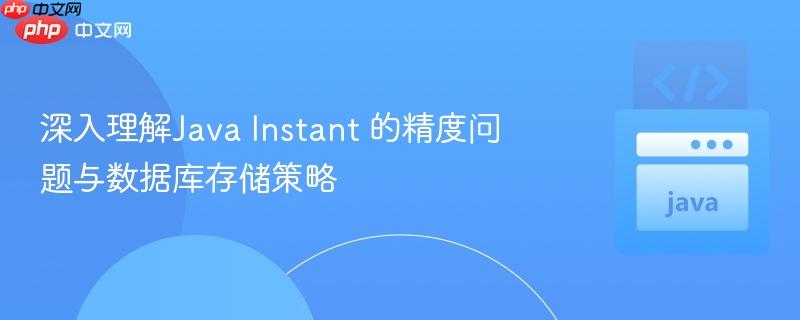
当将java `instant` 对象转换为纪元毫秒(`toepochmilli()`)后再重建 `instant` 时,原始 `instant` 的纳秒级精度会丢失。这是因为 `toepochmilli()` 方法会截断任何超出毫秒的精度信息,导致重建的 `instant` 无法与原始 `instant` 完全相等。本文将详细解释这一现象,并提供在数据库中正确存储 `instant` 以保留其完整精度的最佳实践。
Java 8 引入的 java.time.Instant 类代表时间线上的一个瞬时点,它以 UTC 时间表示,并能够支持纳秒(nanosecond)级别的精度。这意味着一个 Instant 对象可以精确到十亿分之一秒。这种高精度在需要精确时间戳的场景中非常有用,例如日志记录、事件排序或金融交易。
尽管 Instant 内部维护着纳秒级别的精度,但其 toEpochMilli() 方法在设计上仅返回自 1970-01-01T00:00:00Z 以来的毫秒数。根据 Java 官方文档的说明,如果 Instant 具有大于毫秒的精度,toEpochMilli() 方法在转换时会丢弃任何多余的精度信息,其行为类似于将纳秒部分进行整数除以一百万。
这意味着,当您执行以下操作时:
Instant now = Instant.now(); System.out.println(now.compareTo(Instant.ofEpochMilli(now.toEpochMilli())));
您会发现 System.out.println() 的输出通常不是 0,而是一个正数(例如 897000)。这表明 now 对象比通过 now.toEpochMilli() 重建的 Instant 更“晚”。这是因为 Instant.ofEpochMilli() 方法只能创建一个具有毫秒精度的 Instant,而原始的 now 可能包含了毫秒以下的纳秒部分。当这部分纳秒被 toEpochMilli() 截断后,重建的 Instant 自然会比原始的 Instant 稍微“早”一些。
立即学习“Java免费学习笔记(深入)”;
例如:
显然,这两个 Instant 并不完全相同。
考虑到 toEpochMilli() 的精度损失,在数据库中存储 Instant 时,如果需要保留其完整的纳秒精度,则不应仅仅存储 toEpochMilli() 的结果。以下是几种推荐的存储策略:
这是最通用且推荐的方法,尤其适用于那些没有原生支持纳秒级时间戳的数据库。您可以将 Instant 分解为自纪元以来的秒数和纳秒部分,分别存储为两个独立的列:
Java 存储示例:
import java.time.Instant;
public class InstantStorageExample {
public static void main(String[] args) {
Instant now = Instant.now();
// 提取秒和纳秒
long epochSecond = now.toEpochSecond();
int nanoOfSecond = now.getNano();
System.out.println("原始 Instant: " + now);
System.out.println("存储的秒: " + epochSecond);
System.out.println("存储的纳秒: " + nanoOfSecond);
// 从数据库中读取后重建 Instant
Instant restoredInstant = Instant.ofEpochSecond(epochSecond, nanoOfSecond);
System.out.println("重建的 Instant: " + restoredInstant);
// 验证是否相等
System.out.println("原始 Instant 与重建 Instant 比较结果: " + now.compareTo(restoredInstant));
System.out.println("是否完全相等: " + now.equals(restoredInstant));
}
}数据库表结构示例 (PostgreSQL/MySQL):
CREATE TABLE my_timestamps (
id SERIAL PRIMARY KEY,
event_time_epoch_second BIGINT NOT NULL,
event_time_nano_of_second INT NOT NULL
);一些现代数据库(如 PostgreSQL、MySQL 5.6+、Oracle)提供了支持纳秒甚至更高精度的时间戳类型。
在使用这些类型时,您通常可以直接将 Instant 对象通过 JDBC 驱动传递给 PreparedStatement,或从 ResultSet 中读取。JDBC 4.2 及更高版本提供了对 java.time 类的直接支持。
Java 存储示例 (使用 JDBC 4.2+):
import java.sql.*;
import java.time.Instant;
public class InstantJdbcExample {
private static final String DB_URL = "jdbc:postgresql://localhost:5432/testdb";
private static final String USER = "your_user";
private static final String PASS = "your_password";
public static void main(String[] args) {
try (Connection conn = DriverManager.getConnection(DB_URL, USER, PASS)) {
// 确保表存在
createTable(conn);
Instant now = Instant.now();
System.out.println("原始 Instant: " + now);
// 存储 Instant
String insertSql = "INSERT INTO events (event_name, event_time) VALUES (?, ?)";
try (PreparedStatement pstmt = conn.prepareStatement(insertSql)) {
pstmt.setString(1, "Test Event");
pstmt.setObject(2, now); // 使用 setObject 存储 Instant
pstmt.executeUpdate();
System.out.println("Instant 存储成功。");
}
// 读取 Instant
String selectSql = "SELECT event_name, event_time FROM events WHERE event_name = 'Test Event'";
try (PreparedStatement pstmt = conn.prepareStatement(selectSql);
ResultSet rs = pstmt.executeQuery()) {
if (rs.next()) {
String eventName = rs.getString("event_name");
Instant retrievedInstant = rs.getObject("event_time", Instant.class); // 使用 getObject 读取 Instant
System.out.println("读取的事件: " + eventName + ", 时间: " + retrievedInstant);
// 验证是否相等
System.out.println("原始 Instant 与读取 Instant 比较结果: " + now.compareTo(retrievedInstant));
System.out.println("是否完全相等: " + now.equals(retrievedInstant));
}
}
} catch (SQLException e) {
e.printStackTrace();
}
}
private static void createTable(Connection conn) throws SQLException {
String createTableSql = "CREATE TABLE IF NOT EXISTS events (" +
"id SERIAL PRIMARY KEY," +
"event_name VARCHAR(255) NOT NULL," +
"event_time TIMESTAMP(9) WITH TIME ZONE NOT NULL" + // 使用纳秒精度
");";
try (Statement stmt = conn.createStatement()) {
stmt.execute(createTableSql);
}
}
}注意事项:
虽然可以将 Instant 转换为 ISO-8601 格式的字符串(例如 Instant.toString())并存储在 VARCHAR 或 TEXT 类型的列中,但这种方法通常不推荐。
Instant 的 toEpochMilli() 方法在处理高精度时间戳时存在精度损失。为了在数据库中准确地存储和恢复 Instant 的完整纳秒精度,推荐的方法是:
理解 Instant 的精度特性及其在不同转换和存储场景下的行为,是编写健壮、准确时间处理代码的关键。根据您的应用需求和数据库能力,选择最合适的存储策略,以避免不必要的时间精度问题。
以上就是深入理解Java Instant 的精度问题与数据库存储策略的详细内容,更多请关注php中文网其它相关文章!

每个人都需要一台速度更快、更稳定的 PC。随着时间的推移,垃圾文件、旧注册表数据和不必要的后台进程会占用资源并降低性能。幸运的是,许多工具可以让 Windows 保持平稳运行。

Copyright 2014-2025 https://www.php.cn/ All Rights Reserved | php.cn | 湘ICP备2023035733号